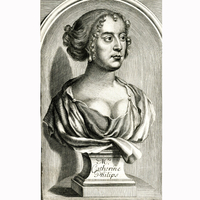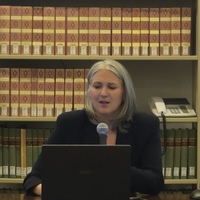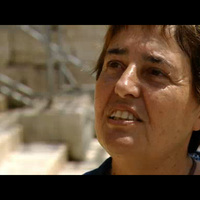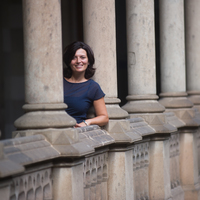PhD Thesis 2013 by Catherine Phillips
Doctoral thesis that looks specifically at Cobenzl, his collection, his motivations and approache... more Doctoral thesis that looks specifically at Cobenzl, his collection, his motivations and approaches for collecting drawings, and at the context in the Southern Netherlands. Cobenzl was collecting outside the 'collecting capitals' - Paris, London, Amsterdam - but the Southern Netherlands were also a crossroads for influences in collecting across Europe.
Papers by Catherine Phillips
Zeichnungsammlungen in Wien und Mitteleuropa: Akteure – Praktiken – Rahmendiskurse, 2024
In the second half of the eighteenth century, collectors of drawings were relatively rare in Vien... more In the second half of the eighteenth century, collectors of drawings were relatively rare in Vienna. The Russian ambassador, Prince Dmitry Mikhaylovich Golitsyn, was therefore all the more remarkable in that he formed a collection of more than 4,000 drawings by Old Masters and, importantly, as many contemporary artists working in Vienna or for the Austrian court as possible. A patron of Mozart, he was a key figure in Vienna's cultural life.

Oud Holland 137/1-2, 2024
Masquerading for many years under the name of Federico Zuccaro, the newly identified modello for ... more Masquerading for many years under the name of Federico Zuccaro, the newly identified modello for the outer wings of the triptych commemorating Maria Snyders (1588-1659) is an important addition to the drawn oeuvre of the Flemish artist Jan Boeckhorst (1604-1668). Its discovery adds to our understanding of his process of work, moving from the depiction of the symbols of the four evangelists proposed in the preliminary drawing towards a more compact and balanced composition. It also provides an opportunity to revisit the dating of the Snyders triptych itself and to reconsider a drawing traditionally associated with it.
More than the finished panel painting, the fluid depiction of the four evangelists' symbols in brown wash and white body colour over black chalk, with delicate touches of oil, accentuates links with Boeckhorst's designs for prints for the Plantin publishing house in Antwerp. The author argues that there is reason to believe that not only was the triptych conceived some time before the death of Maria Snyders in 1659, but that the drawing at least was executed around 1654.
The author also argues that another drawing by Boeckhorst, kept in the Teylers Museum and known under the title Epitaph for Maria Snyders, should be disassociated from the triptych and viewed separately. Not only are there clear indications that it was intended for a print and not as the basis of a painting, but it conveys a different message. If the Snyders triptych speaks of salvation, the drawing in Haarlem promotes veneration of the Virgin Mary as the surest path to Christ, not least through quotations from the works of the ardent Marian Jesuit Petrus Canisius (1521-1597).

L’empire de Catherine la Grande, Nouvelles approches, 2023
Catherine built an empire that was not only physical: she did not merely expand Russia’s territor... more Catherine built an empire that was not only physical: she did not merely expand Russia’s territory, but she created an intellectual empire, drawing in writers and thinkers, artists and craftsmen. Yet though much has been written of Catherine’s understanding of the need for intellectual and artistic engagement with the European discourse, all too often her recognition of the significance of striking and pervasive artistic policies, particularly in terms of patronage and collecting, is ascribed to innate genius. If there has been considerable emphasis on the influence of Europeans on Catherine’s collecting, of Diderot and Falconet, of Grimm and Tronchin, the role of Russians in shaping her attitudes (rather than simply acting as her agent) has been insufficiently studied. This paper argues for greater attention to those around Catherine who helped shape her understanding and determine her cultural policies, in particular to Ivan Ivanovich Betskoy (1704–95).

Krzysztof Pomian, Collectionneurs, amateurs et curieux: Paris, Venise, XVIe-XVIIIe siècle (in Russian), 2022
Under the auspices of the Levinson-Lessing professorship in the history of collecting, a new publ... more Under the auspices of the Levinson-Lessing professorship in the history of collecting, a new publication project was launched to translate key works into Russian. Despite its great significance in this area, Pomian's seminal work had never been translated into Russian. This fine translation from the original French edition by Valery Kislov at last makes the work available to new readers.
Throughout his career Polish-French historian Krzysztof Pomian (1934–) has dealt with concepts of memory and history, in which the meaning of objects have played a central role. This book of essays from the 1970s and 1980s, first published in French in 1987, immediately became the central work for studies in the history of collecting, setting out a factual and theoretical framework for succeeding generations of scholars. Pomian avoids the contemporary division between the collecting of the ‘fine arts’ and other objects, creating a sweeping picture of European collecting practices from the sixteenth to eighteenth centuries. He demonstrates the interdisciplinary place of the history of collecting, at the heart of the history of art, science, society and politics, touching on anthropology and sociology, on meaning and value in the context of different social and economic structures.
Кшиштоф Помян, Коллекционеры, любители и собиратели. Париж, Венеция: XVI–XVIII века, СПб.: Издательство Европейского университета в Санкт-Петербурге, 2022
Francis Haskell, The Ephemeral Museum (in Russian), 2022
In this, the first of Francis Haskell's works to be translated into Russian, he looks at the hist... more In this, the first of Francis Haskell's works to be translated into Russian, he looks at the history of the Old Master exhibition.

Ricche Minere, 2021
Over the course of the nineteenth century there was heated discussion in Russia as to whether a s... more Over the course of the nineteenth century there was heated discussion in Russia as to whether a set of ‘cartoons’ of the Acts of the Apostles belonging to the dealer Lukhmanov were Raphael’s originals, and those at Hampton Court ‘mere copies’. Exhibited several times, they became the centre of a debate that had as much to do with Russian patriotism as with art. In the 1890s efforts were renewed to have them declared originals, this time abroad: in 1891 they were displayed in the ‘ancient manège du prince impérial’ at the Louvre and the owner travelled to Italy, comparing the paintings with the Vatican tapestries and visiting Mantua in an effort to uncover documents proving their authenticity. In 1900 they were shown at the American Art Galleries New York, an accompanying publication arguing that Raphael’s originals had remained in Mantua and ‘the Kensington cartoons’ were the work of Tomasso Vincidor di Bologna, the result of a commission from Pope Leo X to weave tapestries as a gift for Henry VIII. Vincidor, it was said, made drawings of the Raphael tapestries and went off with them to Flanders, where they were used to make the paper cartoons. The works in London, states the text, ‘could not have been those used as models for the Vatican tapestries… The documents adduced and the proofs founded on historical data completely confirm the fact that the Loukmanoff cartoons belong to the brush of Raphael.’ Those arguments were repeated three years later in a polemical article by Lady Colin Campbell, in which she hinted that Britain’s claim to have the original cartoons was rooted in national pride rather than fact.
After a hundred years of debate as to their status, the works thereafter disappear, and their location is not – yet? – known.
In recent years there has been considerable research into the various copies of Raphael’s cartoons and of the tapestries woven from them. The author makes a link between these painted canvases, in Russia from the middle of the eighteenth century, and a set of painted ‘originals’ once belonging to Hercule-Louis Turinetti, Marquis de Prié, deputy governor-general of the Austrian Netherlands between 1716 and 1724, first discussed in The Burlington Magazine in 2014 by Koenraad Brosens and Guy Delmarcel. Brosens and Delmarcel lamented the loss of de Prié’s paintings, which were sent back to Vienna on the owner’s death in 1726, indicating that the description of the unusual technique ‘sows more confusion than it dispels’. So unusual is the technique, which matches that of the Lukhmanov cartoons, that we can tentatively suggest they are one and the same.
The Kuchumov Readings. Volume of Papers from the Scholarly Conference. Attribution, History and Fate of Objects in Museum Collections [Кучумовские чтения. Сборник докладов научной конференции. «Атрибуция, история и судьба предметов из музейных коллекций»], 2021
The Hermitage Museum has the only firmly attributed - and signed - pastel by Anna Dorothea Terbus... more The Hermitage Museum has the only firmly attributed - and signed - pastel by Anna Dorothea Terbusch-Lisiewska. The author places this within the context of the artist's images of women of the demi-monde.

Les Cahiers d’Histoire de l’Art, 2021
Ange-Laurent Lalive de Jully, propagandist of the achievements of French art, developed an unlike... more Ange-Laurent Lalive de Jully, propagandist of the achievements of French art, developed an unlikely friendship with the Austrian ministre plénipotentiaire in the Southern Netherlands, count Charles de Cobenzl, whose admiration was reserved for Flemish art. Between 1762 and 1768 they exchanged gifts and opinions, light-heartedly seeking to convince each the other of the superiority of their preferred national schools. Cobenzl presented Lalive with two small Flemish paintings and asked Lalive to arrange for prints to be made after his favourite Dutch and Flemish works; Lalive sought to introduce Cobenzl to the merits of his favourite painter, Greuze. Lalive’s gifts to the minister included a set of large drawings relating to Charles Natoire’s paintings in the Chapelle des Enfants-Trouvés in Paris. Long dismissed as copies produced during the printmaking process, those drawings are here reassessed in the light of their own merits and the relationship between these two very different men. It becomes clear that they are autograph works by Natoire, made after his paintings, which should probably be placed within the artist’s practice of producing drawn records of his works.

Attributions of Objects: Intuition, Experience, Documents. XXVII Tsarseko Selo Scholarly Conference / Атрибуция предмета: интуиция, опыт, документ. XXVII Царскосельская научная конференция, 2021
None of the 22 drawings given to Michelangelo in the collection of Count Cobenzl, acquired by Cat... more None of the 22 drawings given to Michelangelo in the collection of Count Cobenzl, acquired by Catherine the Great for her Hermitage in 1768, is in fact the work of the artist. Indeed, the styles of these sheets are so different, that it is hard to imagine how they could all have been given to the same artist in the eighteenth century. In the nineteenth century, most were set aside as 'copies'. Yet once stripped of their impressive but utterly incorrect attribution, many of these drawings prove to be more than just copies, of considerable interest in their own right. Three examples were chosen to illustrate the riches behind the name of Michelangelo. The only one previously published is a "Resurrection" now given to a Nuremberg artist of the second quarter of the 16th century, close to Georg Pencz. The second is a copy of Rubens' reworking of a drawing after Michelangelo's Brazen Serpent: Rubens cut up the drawing and reassembled the pieces, creating an entirely new composition (British Museum). Jeremy Wood wondered at the existence of a copy of this reworked composition by Abraham van Diepenbeeck (Biblioteca Ambrosiana, Milan), but the Hermitage copy is more remarkable, being much closer to Rubens' creation. The third drawing chosen for this paper is a red chalk "Descent from the Cross", reflecting Michelangelo's drawing in the Teylers Museum, Haarlem. Rather than being the work of Daniele da Volterra, its traditional attribution in the 20th century, this drawing was probably produced as part of the process of reproducing the composition in ivory or metal: such reliefs are known in the Bargello and the Museo degli Argenti in Florence, in the Vatican, the Residenz in Munich, and elsewhere. None of the drawings is the work of Michelangelo, yet each says something about the wider artistic context in which it was produced, and in which the drawings were perceived in the 18th century.

Master Drawings, Winter 2021, pp. 499–528, 2021
Studies of eighteenth-century collecting in the Swiss cantons have had relatively little material... more Studies of eighteenth-century collecting in the Swiss cantons have had relatively little material to work with in terms of drawings. The picture was very different in each canton, but drawings were still largely concentrated in established major centres of production. Well into the 1700s they continued to be seen as working material, passed from hand to hand or kept in the workshop to be copied, and there were only a limited number of non-Swiss/German works in circulation. Looking at collectors in Basle, Yvonne Boerlin-Brodbeck found just two concentrating on works on paper, both in the second half of the century. But Johann Caspar Füssli, portrait painter and writer of Zurich, took advantage of the state of the market in Zurich to form what seems to have been a remarkable collection, frequently referenced in his biographical dictionary of Swiss artists. With the help of Boerlin-Brodbeck's research, it has been possible to identify a number of drawings deriving from Füssli's collection now in the Hermitage Museum. They arrived as part of the collection of Charles Cobenzl, having been supplied to him by the Swiss gentleman Rodolphe Valltravers.
Искусствознание [Art Studies], 2020
The relatively few known depictions of Timoclea predominantly show her standing before Alexander ... more The relatively few known depictions of Timoclea predominantly show her standing before Alexander of Macedonia, illustrating the magnanimity and wisdom of the monarch. Such is the most famous painting on the subject by Domenichino. A minority, however, depict the ‘crime’ for which she was brought before Alexander, the killing of her rapist, a Thracian captain, by tossing him into a well. Such was the choice of Elisabetta Sirani, whose painting has become a symbol for female resistance to violence in the 21st century. This article shows how other works, including a drawing in the Hermitage, introduce nuances to the subject, and demonstrates how artists’ treatments of Timoclea derive in part from the two slightly different versions of her story provided by Plutarch.
Silver Studies. The Journal of the Silver Society, 36, 2020
Kuchumov Readings (Кучумовские чтения. Сборник докладов научной конференции. «Атрибуция, история и судьба предметов из музейных коллекций»), 2020
A sculpture by Laurent Delvaux, apparently made for Count Charles Cobenzl, was sold to Catherine ... more A sculpture by Laurent Delvaux, apparently made for Count Charles Cobenzl, was sold to Catherine the Great of Russia as part of Cobenzl's collection in 1768. Transferred to one of the royal summer palaces, it spent some time at Gatchina and is now at Pavlovsk. More than any other work in the Cobenzl collection of 46 paintings, over 4000 drawings and 13 sculptures, it reflects his role in support for the arts and the artistic industries in the Southern Netherlands, where he was minister.
Master Drawings, Summer, 2020
A review of the catalogue of the exhibition of drawings from the Pushkin Museum in Moscow, Le Mus... more A review of the catalogue of the exhibition of drawings from the Pushkin Museum in Moscow, Le Musée Pouchkine. Cinq cents ans de dessins de maîtres, held at the Fondation Custodia in Paris.
The Burlington Magazine, September, 2019
A review of the exhibition of works by Jacob Jordaens in Russian collections, held first at the H... more A review of the exhibition of works by Jacob Jordaens in Russian collections, held first at the Hermitage Museum in St Petersburg (2 March - 26 May 2019) and then at the Pushkin Museum of Fine Arts in Moscow (16 September - 30 November 2019)
Print Quarterly, 2019
Only 26 prints by the architect and sculptor Pierre Biard II (1592–1661) were published inRobert-... more Only 26 prints by the architect and sculptor Pierre Biard II (1592–1661) were published inRobert-Dumesnil's Le peintre-graveur français. A small sheet in the Hermitage can now be added to this small corpus. It is all the more remarkable in that it is after a small drawing by Michelangelo, a lamp design that seems not to have drawn the attention of any other engravers or artists at that time.

Эрмитажные чтения памяти В.Ф. Левинсона-Лессинга (02.03.1893 – 27.06.1972). 2017–2018 [In Memoriam Vladimir Levinson-Lessing (02.03.1893 – 27.06.1972). Proceedings of the Conferences 2018–2018], 2018
In 1975 Irina Novosselskaya published fourteen large drawings by Charles Natoire (1700–1777) rel... more In 1975 Irina Novosselskaya published fourteen large drawings by Charles Natoire (1700–1777) relating to the Chapelle des Enfants-trouvés in Paris. Natoire completed his vast canvases around 1750 but a mere fifteen years later they had suffered so much from damp that they were considered damaged beyond repair. Only a series of prints by Etienne Fessard remained, issued 1752–59, and the Hermitage drawings. Analysing the latter, Novosselskaya concluded that they were copies after the prints. French scholars who had not seen the originals went on to propose the hypothesis - which soon came to be accepted as 'fact' - that the Hermitage drawings could be identified with lost drawings by the engraver himself, mentioned in letters and documents. Recent studies of Natoire's work led this author to return to the attribution of the drawings and to conclude that there is no basis to reject his authorship, particularly since the drawings once belonged to the connoisseur and former pupil of Natoire, Ange-Laurent La Live de Jully, who declared them to be among the finest achievements of French art.

In Monte Artium. Journal of the Royal Library of Belgium, 2018
In about 1600 Pedro de Ribadeneira, author of the most widespread early biographies of Ignatius o... more In about 1600 Pedro de Ribadeneira, author of the most widespread early biographies of Ignatius of Loyola, commissioned a series of sixteen large paintings illustrating the life of the founder of the Jesuit Order for the Jesuit house in Madrid. A few years later, as the campaign for beatification and canonisation of Ignatius gained momentum, he had prints made after these paintings, which were published in Antwerp in 1610. Although the original paintings by Juan Mesa are lost the prints, produced in the Galle workshop, are well known. The identification of seven drawings for these prints in the Hermitage Museum in St Petersburg, which arrived as part of the collection of Charles Cobenzl, formed in Brussels in the 1760s, allows the author to consider the process by which the paintings were turned into prints and the identity of the artist involved.

Metropolitan Museum Journal, 2018
This article adds a drawing in the Hermitage Museum in St Petersburg to a series by the Flemish-b... more This article adds a drawing in the Hermitage Museum in St Petersburg to a series by the Flemish-born artist Matthieu Elias, of which ten are in the Metropolitan Museum. The series illustrates the life of Dom Jean de La Barrière (1554–1600), founder of the French Order of Feuillants, whose opposition to the Catholic League and support for the religious tolerance of Henry III and Henry IV of France led to his persecution. In 1587 Henry III founded a Feuillant monastery in Paris; in the 1620s just over half the forty windows in the cloister were filled with painted glass showing the life of Jean de La Barrière, but the remaining nineteen windows were to be completed only 1701–1709. Designed by Matthieu Elias, they were highly regarded in the eighteenth century. Removed to the Musée des Monuments Français in Paris in the wake of the Revolution, the glass was lost when this was dispersed in 1816. The drawings are thus our best record of the once-famous glass of the Couvent des Feuillants. The author identifies the subjects and considers the purpose of the drawings, whether as models for the glass-painters or as finished presentation sheets.










Uploads
PhD Thesis 2013 by Catherine Phillips
Papers by Catherine Phillips
More than the finished panel painting, the fluid depiction of the four evangelists' symbols in brown wash and white body colour over black chalk, with delicate touches of oil, accentuates links with Boeckhorst's designs for prints for the Plantin publishing house in Antwerp. The author argues that there is reason to believe that not only was the triptych conceived some time before the death of Maria Snyders in 1659, but that the drawing at least was executed around 1654.
The author also argues that another drawing by Boeckhorst, kept in the Teylers Museum and known under the title Epitaph for Maria Snyders, should be disassociated from the triptych and viewed separately. Not only are there clear indications that it was intended for a print and not as the basis of a painting, but it conveys a different message. If the Snyders triptych speaks of salvation, the drawing in Haarlem promotes veneration of the Virgin Mary as the surest path to Christ, not least through quotations from the works of the ardent Marian Jesuit Petrus Canisius (1521-1597).
Throughout his career Polish-French historian Krzysztof Pomian (1934–) has dealt with concepts of memory and history, in which the meaning of objects have played a central role. This book of essays from the 1970s and 1980s, first published in French in 1987, immediately became the central work for studies in the history of collecting, setting out a factual and theoretical framework for succeeding generations of scholars. Pomian avoids the contemporary division between the collecting of the ‘fine arts’ and other objects, creating a sweeping picture of European collecting practices from the sixteenth to eighteenth centuries. He demonstrates the interdisciplinary place of the history of collecting, at the heart of the history of art, science, society and politics, touching on anthropology and sociology, on meaning and value in the context of different social and economic structures.
Кшиштоф Помян, Коллекционеры, любители и собиратели. Париж, Венеция: XVI–XVIII века, СПб.: Издательство Европейского университета в Санкт-Петербурге, 2022
After a hundred years of debate as to their status, the works thereafter disappear, and their location is not – yet? – known.
In recent years there has been considerable research into the various copies of Raphael’s cartoons and of the tapestries woven from them. The author makes a link between these painted canvases, in Russia from the middle of the eighteenth century, and a set of painted ‘originals’ once belonging to Hercule-Louis Turinetti, Marquis de Prié, deputy governor-general of the Austrian Netherlands between 1716 and 1724, first discussed in The Burlington Magazine in 2014 by Koenraad Brosens and Guy Delmarcel. Brosens and Delmarcel lamented the loss of de Prié’s paintings, which were sent back to Vienna on the owner’s death in 1726, indicating that the description of the unusual technique ‘sows more confusion than it dispels’. So unusual is the technique, which matches that of the Lukhmanov cartoons, that we can tentatively suggest they are one and the same.
More than the finished panel painting, the fluid depiction of the four evangelists' symbols in brown wash and white body colour over black chalk, with delicate touches of oil, accentuates links with Boeckhorst's designs for prints for the Plantin publishing house in Antwerp. The author argues that there is reason to believe that not only was the triptych conceived some time before the death of Maria Snyders in 1659, but that the drawing at least was executed around 1654.
The author also argues that another drawing by Boeckhorst, kept in the Teylers Museum and known under the title Epitaph for Maria Snyders, should be disassociated from the triptych and viewed separately. Not only are there clear indications that it was intended for a print and not as the basis of a painting, but it conveys a different message. If the Snyders triptych speaks of salvation, the drawing in Haarlem promotes veneration of the Virgin Mary as the surest path to Christ, not least through quotations from the works of the ardent Marian Jesuit Petrus Canisius (1521-1597).
Throughout his career Polish-French historian Krzysztof Pomian (1934–) has dealt with concepts of memory and history, in which the meaning of objects have played a central role. This book of essays from the 1970s and 1980s, first published in French in 1987, immediately became the central work for studies in the history of collecting, setting out a factual and theoretical framework for succeeding generations of scholars. Pomian avoids the contemporary division between the collecting of the ‘fine arts’ and other objects, creating a sweeping picture of European collecting practices from the sixteenth to eighteenth centuries. He demonstrates the interdisciplinary place of the history of collecting, at the heart of the history of art, science, society and politics, touching on anthropology and sociology, on meaning and value in the context of different social and economic structures.
Кшиштоф Помян, Коллекционеры, любители и собиратели. Париж, Венеция: XVI–XVIII века, СПб.: Издательство Европейского университета в Санкт-Петербурге, 2022
After a hundred years of debate as to their status, the works thereafter disappear, and their location is not – yet? – known.
In recent years there has been considerable research into the various copies of Raphael’s cartoons and of the tapestries woven from them. The author makes a link between these painted canvases, in Russia from the middle of the eighteenth century, and a set of painted ‘originals’ once belonging to Hercule-Louis Turinetti, Marquis de Prié, deputy governor-general of the Austrian Netherlands between 1716 and 1724, first discussed in The Burlington Magazine in 2014 by Koenraad Brosens and Guy Delmarcel. Brosens and Delmarcel lamented the loss of de Prié’s paintings, which were sent back to Vienna on the owner’s death in 1726, indicating that the description of the unusual technique ‘sows more confusion than it dispels’. So unusual is the technique, which matches that of the Lukhmanov cartoons, that we can tentatively suggest they are one and the same.
It was to be found more than two hundred years after his death, in Spring 1975, when the classical scholar and renowned expert in gems, Oleg Neverov, chanced upon them at the bottom of a pile of papers in the archives of the State Hermitage Museum in St Petersburg. Neverov and his colleague Julia Kagan carried out initial research on the Hermitage manuscripts and produced the first published account of this archival treasure.
The present volume builds upon their earlier work to produce the first comprehensive publication of Museum Britannicum, presenting Natter’s drawings and comments alongside modern information on the gems that can be identified and located. This book is the result of a ten-year collaboration between scholars on the Beazley Archive gems research programme at Oxford’s Classical Art Research Centre and the State Hermitage Museum.
To study artistic context, taste and the market requires a broader study of the full range of artistic output and collector acquisitions. To look at everything in a collection, create a true catalogue raisonné, allocating to each object an equal amount of attention, has multiple benefits. No longer blinded by a collector’s most striking works, it becomes possible to more truly assess individual and contemporary taste, as well as market availability. Lesser known actors, whether artists, dealers or intermediaries, are brought to the fore. And works that have been ignored by changing tastes or lack of understanding are removed from the shadow of the accepted canon, allowing the ’discovery’ of objects that contribute to a better understanding of individual artists and of wider art history. This paper looks at the contribution made to the study of Old Master drawings by concentrated attention on a collection in its entirety, rather than individual sheets.
Significantly, the Hermitage was not part of the Winter Palace itself: Catherine’s collections were separate from where she worked and slept. The Hermitage was a place of entertainment and relaxation, in which paintings, prints and gems played an important role. Catherine’s Hermitage was not a feminine space in the sense of standing apart from ‘main’ (masculine or public) spaces, since it was attached to the ‘main’ space (the monarch’s official residence) and was open to the select public. With a keen appreciation of her collections’ usefulness as a practical resource, she used them for intellectual and political purposes: they provided the inspiration for historic costumes for plays put on in the Hermitage Theatre, and she personally used them as a political tool, to impress the world both through reputation (a ‘catalogue’ was printed in 1774) and directly, through display to foreign representatives.
Paris, 27–29 May 2019
https://www.singer-polignac.org/fr/missions/sciences/colloques/2433-l-empire-de-catherine-la-grande-nouvelles-approches#pjobst
Catherine the Great founded the now internationally-renowned drawings collection of the Hermitage Museum with the purchase in 1768 of the cabinet of Count Charles Cobenzl (Brussels). At a time when there were no collections of drawings in Russia, no collectors to emulate, and no established tradition, the purchase of over four thousand drawings was a radical act, far more innovative than the purchase of paintings. What led Catherine to make the purchase? What was its purpose? Did she herself understand the significance of the acquisition?
So much has been said and written about the influence of foreign writers and thinkers on Catherine and her policies, particularly as relates to the arts, that less insistent voices stressing the role played by Russians in shaping and informing her understanding of the role of the arts in the immediate period after she came to power sometimes go unheard.
Looking at Catherine’s correspondence and analysing the chronology and nature of Catherine’s collecting of things other than paintings, it becomes clear that in the first years of Catherine’s reign she owed much to the advice and knowledge of several Russians who had spent time in Europe. It was men such as Ivan Betskoy, the éminence grise of Catherine’s cultural projects, Dmitry Mikhaylovich Golitsyn and Dmitry Alexeevich Golitsyn who persuaded her of the significance of artistic policies overall, but it seems also to be they who convinced her that the possession of a collection of drawings was a necessary mark of ‘belonging’ to a European intellectual elite. Between 1755 and 1761 Ivan Betskoy was travelling in Europe with his niece and her husband – Dmitry Mikhaylovich Golitsyn. They spent considerable time in Paris, not the only place where drawings were being actively collected but the centre of theoretical discussions of the value and purpose of drawings collections. Young Dmitry Alexeevich Golitsyn also came into contact with them in this period. So it is telling that the first collections of drawings formed by Russians belonged to Betskoy and D. M. Golitsyn and that D. A. Golitsyn was to be the intermediary for the purchase of the Cobenzl drawings, to buy at the Muilman sale of drawings in later years, and to form his own collection of Dutch drawings.
The European experience of these men in the second half of the 1750s and early 1760s was key to Catherine’s understanding of the importance of art as a political and propaganda weapon. Was she also influenced by the example of Stanisław Poniatowski, who was to form his own important collection of drawings? And did Catherine, whose attitude to art was markedly pragmatic, truly see the function of drawings as the object of collecting (in contrast to their function as, for instance, an aid to study for those training at the Academy of Arts), or was their possession merely part of her desire to be seen to have the right cultural credentials, to be a truly European monarch?
Cobenzl’s vast network of correspondents kept him informed of events across Europe, while the discussion and supply of art allowed him to maintain and extend that network through exchange and mutual service. Via Baron Heinrich Jacob von Haeckel, Cobenzl helped supply paintings to Wilhelm VIII of Hesse-Kassel, but his abundant personal correspondence shows that until his arrival in Brussels his understanding of art was simply that of any educated gentleman. Initially he offered his contacts Italian works ¬– in 1753 he offered Wilhelm VIII works by Pellegrino and Beccafumi – but after his move to the Southern Netherlands he was quite rapidly transformed into a ‘patriot’ of the arts of the region. In 1756, for instance, he acquired Diana Departing for the Hunt, then given to Rubens, for Wilhelm VIII (Gemäldegalerie, Kassel).
On his arrival in Brussels Cobenzl immediately set about revitalising artistic education and the creative industries in the Southern Netherlands. He promoted the value – economic and artistic – of Flemish tapestries and Flemish art in general to the government in Vienna. When he embarked on his own collection c. 1760 the emphasis was firmly on Flemish and Dutch art and he developed a veritable passion for Rubens, expressed both in the wish to own works and the desire to make sure that those in churches were well-maintained and restored. Of the 46 paintings in the cabinet he sold to Catherine the Great in 1768, nineteen were Flemish, nineteen Dutch; of the four thousand drawings, where he sought ‘completeness’, nearly 30 % were Netherlandish.
Corresponding with colleagues in Vienna and with his direct superior Prince Kaunitz, Cobenzl promoted Flemish painting in the Austrian capital. His letters to Winckelmann show him trying vainly to persuade this admirer of Classical art of the superiority of Rubens (‘mon héros’) and as La Live de Jully tried to convert him to a love of French art he responded with a gift of pictures by Neeffs. Cobenzl remained unconvinced of the merits of French art. Agitating for the establishment of an academy for young Flemish artists in Rome, he wrote to Dorn: ‘Nous ne produisons pas des Rubens, mais je suis bien trompé si nous ne surpasserions pas bientôt ce Greuze, qui fait l’admiration de Paris et bien peu la mienne.’
Cobenzl’s correspondence with friends, colleagues and booksellers in the German-speaking lands charts his ‘conversion’ to a love of Flemish art. It shows him balancing a newly-shaped ‘patriotism’ for the art of the Southern Netherlands with his loyalty to Vienna, justifying himself against accusations that he had, as it were, ‘gone native’.
This book unfolds the history of Semenov’s gallery against the background of the development of scholarship and the market for works of art in Russia – and in Europe – during the second half of the nineteenth and early twentieth century, and the transformation of the Hermitage museum from private imperial gallery to state museum.